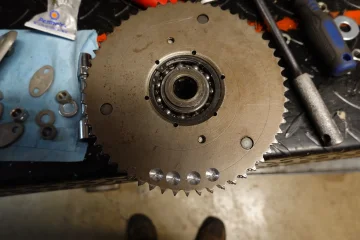OK... I have to jump in.
Given that the engine is a parallel twin and that balance/vibration can never naturally be like a
6 cylinder inline (which is pretty ideal), and given that the vernier isoelastics I have installed do not get rid of the balance
problem but just isolate it from the rider, is it worth balancing various components?
Dennis
What balance 'problem' are you referring to?
If we are talking engine rotating parts, you need to address the 'balance factor.' A percentage of the reciprocating weight of the oil, pistons/rings and rods is taken into account when balancing the crank, pistons and rods. Suitable weights are attached to the crank to represent this weight during the balancing exercise.
But the balance factor in use in a Commando factory supplied engine is 50%. In a rigidly mounted but similar engine, the balance factor is much higher, maybe up to high 70s. For example, a Commando engine installed in a Rickman, Seeley or Featherbed frame needs a different balance factor compared to the same engine in a Commando installation.
Neither are wrong, they are appropriate to the engine mounting method, but also and the use the bike is put to. That is, appropriate to the rpm range you use most, because that is where you are trying to minimise engine vibration. Pointless balancing for 7500rpm if peak power is at 6000rpm, and you never exceed 6500, or you only use max 4000rpm for cruising all day.
If an issue does exist it may be that whilst the factory selected a 50% balance factor they may not have executed the balancing well, or the pistons and rods may be mismatched in weight, originally or through life when different pistons and rods may have been fitted that affect the balance factor.
Due to the isolastics you might never notice, but if you are aware of a problem attributable to crankshaft balance in your Commando, you may need to simply redo calculations based on the actual parts you have and rebalance the crank. If you have access to a suitable balancer, you can consider dynamic balancing versus static balancing to address the balance along the longitudinal axis of the crank! Static balancing has proven adequate in many cases.
The discussion of a balance factor does not apply to a clutch.
The OP is discussing a simple static balancing exercise, more similar to wheel balancing than crank balancing. Greg is teasing!



